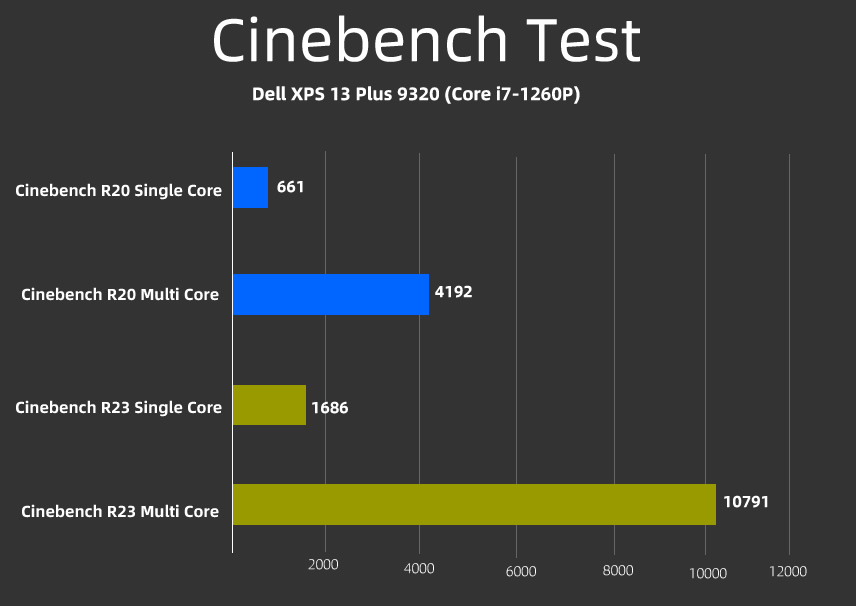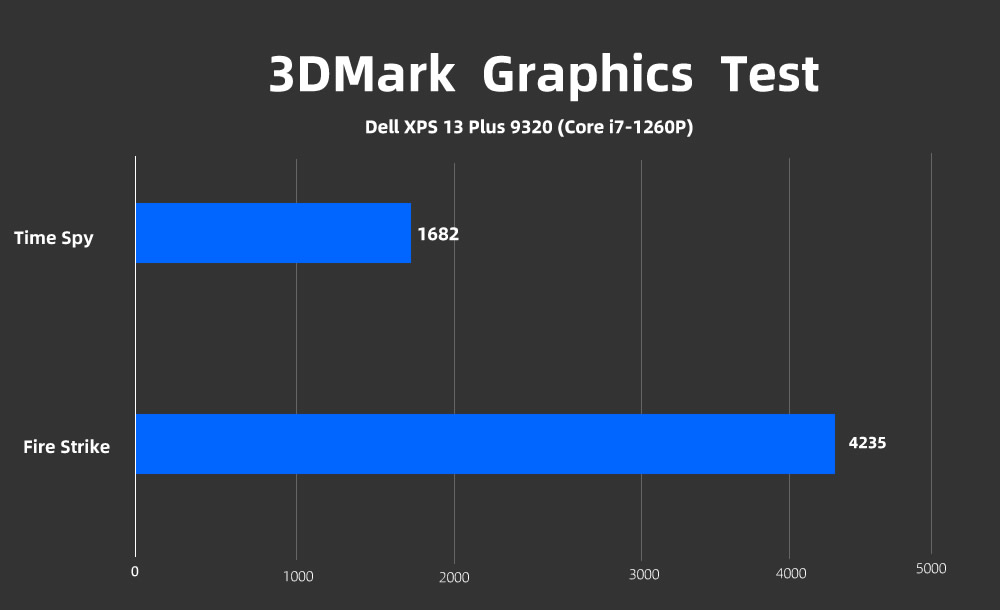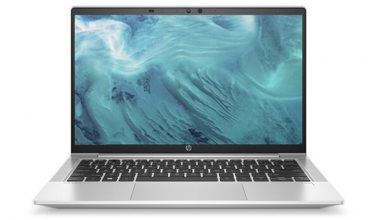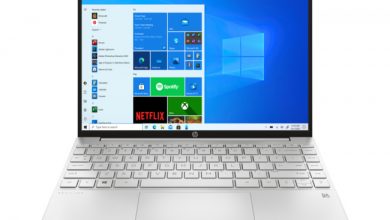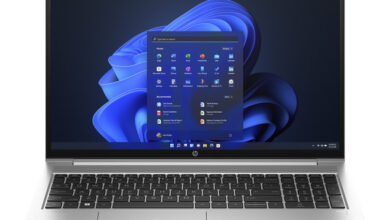A few days ago, we reviewed the Dell Inspiron 16 Plus. If you’re looking for a thin and lightweight laptop with ultra-high performance, then this laptop is one of the best options in the gaming segment.
The laptop we are reviewing today is from the same brand but belongs to the business segment. Due to the increasing competition in this segment, Dell will continue to launch new laptops to stay ahead of the competition. This laptop is named Dell XPS 13 Plus 9320.
The model we reviewed is powered by Intel’s latest 12th Gen Core i7 P-Series processor, which is more powerful and consumes more power than Intel’s U-Series processors. The processor also has an integrated Intel Iris Xe graphics. The laptop also comes with DDR5 RAM and a PCIe 4.0 SSD.
Specifications
| Screen | 13.4″, 3.5K 3456 x 2160, 60Hz, OLED, Touch, Anti-Reflect, 400 nits, InfinityEdge |
| Processor | Intel Core i7-1260P (18MB cache, up to 4.7 GHz, 12 cores) |
| Wireless Connection | Intel Killer Wi-Fi 6 1675 (AX211) 2×2 wireless card, Bluetooth 5.2 |
| Graphics card | Intel Iris Xe Graphics |
| Memory | 32 GB, 2 x 16 GB, LPDDR5-5200 MHz, dual-channel |
| Storage | 2TB PCIe 4.0 M.2 NVMe SSD |
| Ports | 2x USB Type-C Ports |
| Battery | 3 Cell, 55Wh Li-ion battery with 60W AC adapter |
| OS | Windows 11 Home |
| Weight | 2.77 lbs. (1.26 kg) |
Design
The dimensions of the XPS 13 Plus are 295.30 x 199.04 x 15.28 mm, and the weight is around 1.25 kg. It doesn’t break any records in terms of thickness and weight. However, it still maintains a slim body, giving it a very lightweight and flagship laptop feel, so we can say that this laptop is relatively excellent in terms of portability.
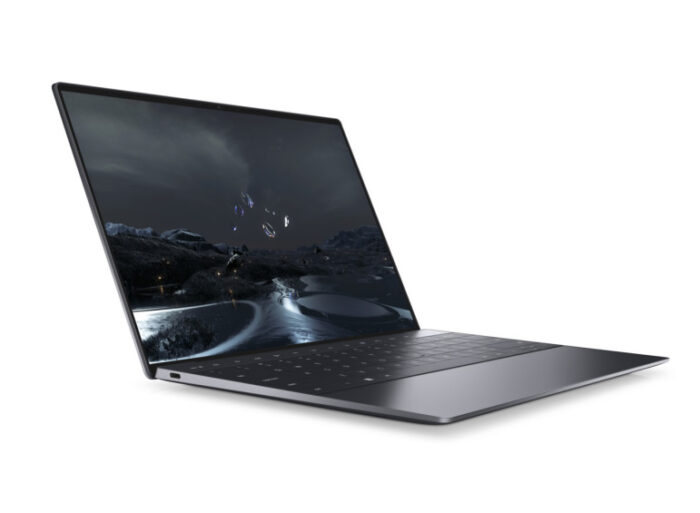
The models we have selected for review have Platinum Color (Silver). This laptop is available in two color options (platinum and graphite), both of which represent the simplicity of the design in a unique way. The entire body is made of aluminum, which ensures that the surface and edges of the laptop look more refined and eye-catching.
The display case has the traditional Dell signature logo in the middle. To achieve a slim body, the manufacturer has also made compromises on the ports, which are discussed further in the port section. It’s also worth mentioning that the Dell XPS 13 Plus is the first laptop in the XPS series to be manufactured using hydro-powered renewable energy. It also reduces carbon emissions from aluminum manufacturing and comes with new packaging that is 100% made from sustainably sourced or renewable materials.
Display
The XPS 13 Plus 9320 features a 13.4-inch OLED touch display with a 91.9% screen-to-body ratio. But due to the narrow bezels, the display doesn’t feel like a small screen. Compared to the old model, the visual experience is more precise, and the display area is wider.
The XPS 13 Plus’s OLED display has a 3.5K (3456 x 2160) resolution, a 16:10 aspect ratio, a 60Hz refresh rate, and 400 nits brightness. It also supports anti-reflection and InfinityEdge. According to the official introduction, the laptop also supports 100% DCI-P3 wide color gamut and provides a reliable and accurate screen viewing experience. Not only that, but the screen also supports hardware-level anti-blue light technology, allowing users to watch the screen for a long time without eye strain or headaches.
In the display calibration test, we obtained the following results: 100% sRGB, 96% Adobe RGB, 100% DCI-P3, and 94% NTSC color gamut coverage. The colors are now more vivid and bright, and the black display has been significantly improved, becoming darker and more realistic than ordinary LCD screens. In the color accuracy test, the minimum DeltaE value was 0.18, the maximum DeltaE was 2.20, and the average DeltaE was 0.80. The color test also indicated that the laptop was suitable for advanced graphic design.

The XPS 13 Plus display has narrow bezels on all four sides. However, the manufacturer did not compromise on the webcam feature and placed a camera module and a dual-array microphone on the top bezel of the screen. The webcam module supports HD video recording at 30fps and good video quality during video conferences. The webcam also supports the Windows Hello feature for a faster login experience.
Keyboard and touchpad
Once you open the laptop, the most attractive thing is its keyboard design. The Dell XPS 13 Plus comes with a platinum backlit keyboard with an integrated fingerprint sensor. The keyboard has a mesh-less design, which reduces the spacing between keys. After using it for a while, fingers can quickly get used to typing on this keyboard without feeling crowded.
Due to the low thickness of the laptop, it was expected that the keyboard would also have a short key travel. However, the result exceeded our expectations, as the key travel is sufficient for further typing. The keycaps are also curved at 0.3 mm, which fits the fingertips perfectly. The keyboard also supports a white LED backlight.
Another highlight of the keyboard is its function keys, which are covered in glass, have a built-in display, support touch, and can be changed via the Fn key. These keys may look similar to the MacBook Pro’s Touch Bar, but they are still very different from each other. However, there is no doubt that the design of the function keys improves the overall appearance of the keyboard..
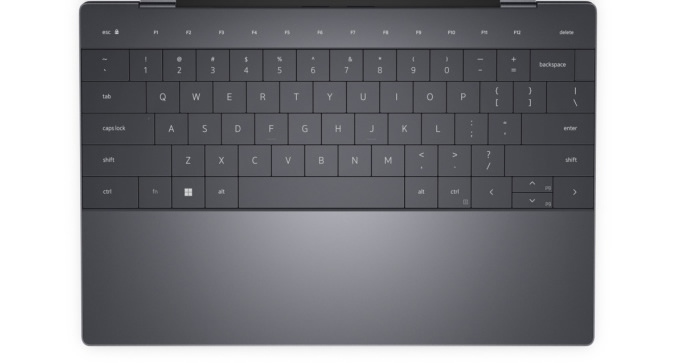
Under the keyboard, you may be wondering if there is no TouchPad. It is worth mentioning that the entire palm rest area under the keyboard is a TouchPad. It might be a mistake to call it a touchpad, as it uses a new technology called ForcePad, which provides borderless haptic feedback when tapped, as well as easy access to the left and right menus. The TouchPad is built with piezoelectric technology under glass, using a series of small drive motors to provide more precise feedback.
Undoubtedly, the entire keyboard area of the XPS 13 Plus is the most exciting and innovative aspect of the device. The seamless glass touchpad (ForcePad), function keys with capacitive touch capabilities, and a large meshless keyboard play a crucial role in maintaining your laptop’s visual and technology features.
Ports
The XPS 13 Plus comes with two USB Type-C Thunderbolt 4 ports on both sides (one on each side). To design a thin body, manufacturers have to make compromises on the ports of the laptop. Since the laptop is used in the business sector, it requires different ports. However, the manufacturer has made some compensations for this, offering a USB-C to USB-A 3.0 adapter and a USB-C to 3.5mm headphone dock in the retail box of the laptop.
Additionally, support for Thunderbolt 4 eliminates the need for separate charging and HDMI ports, as users can charge with two Type-C ports.
Battery and charging
When buying a business laptop, the battery is one of the most important features that buyers must consider before making a purchase. Good battery life is very important in office usage. The XPS 13 Plus is expected to come with a small battery due to its thin and light body.
The XPS 13 Plus comes with a built-in 3-cell 55Wh battery, which seems a bit low for an OLED screen. The battery model number is MN79H, and it has a capacity of 4,524mAh.
To test battery life, we used PCMark 10 Modern Office Mode. Before starting the test, the battery was at 99% and the following settings were set: energy efficiency mode was enabled, 40% brightness, keyboard backlight and Bluetooth were turned off, and Wi-Fi was turned on. With the above settings, the battery lasts 7 hours and 41 minutes, but 10% of the battery remains. The battery life is very different from what we expected, and in normal office use, users can easily spend their office hours on a single charge (an average of 8 hours).
The laptop also comes with a 60W adapter designed for fast charging, which can quickly charge 80% of the battery in just one hour.
RAM and SSD
The XPS 13 Plus comes with 32GB of dual-channel LPDDR5 RAM soldered to the motherboard, which does not allow users to upgrade the RAM. Using the latest DDR5 memory modules ensures that the notebook will not cause speed issues for the next 2-3 years. If the user buys a laptop for office work, 32GB of RAM is more than enough.
To test the RAM capabilities, we used the AIDA64 memory test, and the results were as follows: a read speed of 61,475 MB/s, a write speed of 63,106 MB/s, and a copy speed of 70,289 MB/s, with a latency of 110 ns. Compared to its competitor, the ThinkPad Carbon X1 (2022), the score is slightly lower because the competitor has a better frequency of DDR5 RAM.
This laptop comes with a 2TB NVMe M.2 SSD, which supports PCIe 4.0 Gen protocol and is manufactured by SK Hynix (model number: PC801). The laptop also offers other storage options: 512GB and 1TB. It only has one SSD slot, so if you need more storage space, you’ll need to replace your current SSD.
To test SSD performance, we used the CrystalDiskMark application and obtained the following results: 7,041.66 MB/s for sequential read speed, 6,212.45 MB/s for sequential write speed, 332.60 MB/s for 4K random read speed, and 475.86 MB/s for 4K random write speed. The SSD performance of the XPS 13 Plus is relatively impressive compared to its competitors, ensuring fast copying, saving, and writing during office use.
To replace these components, check out the Dell XPS 13 Plus teardown post.
CPU Benchmarks
In the past, we’ve seen thin and light laptops usually with lower specifications, and these laptops were typically used for browsing the web and working on office documents. However, over time, the requirements have changed. The use of Photoshop, video editing software, rendering movie apps, and many other related tasks has become necessary in today’s slim laptops.
In the case of the XPS 13 Plus, there is no need to worry as the laptop is equipped with Intel’s latest P-series processors, which are typically designed for the laptop segment with a slim body and powerful performance.
The laptop we’re reviewing is powered by Intel’s 12th Gen Core i7-1260P CPU, which has 12 cores and 16 threads with Intel Iris Xe graphics and 18MB of L3 cache. We did some benchmarking on the CPU.
Cinebench: In Cinebench R20, the CPU scored 661 points on the single-core test and 4,192 points on the multi-core test. In Cinebench R23, it scored 1,686 on the single-core test and 10,791 on the multi-core test.
CrossMark: This laptop received 1,731 points (including 1,653 points for productivity, 1,875 points for creativity, and 1,559 points for responsiveness).
X264 FHD benchmarks: In this test, the laptop spent 45 seconds encoding 2,500 frames at a frame rate of 56 fps. Thanks to the Core i7-1260P’s hybrid architecture, the benchmark results are pretty good.
GPU Benchmark
The Core i7-1260P CPU also integrates Intel Iris Xe graphics based on the 10nm Alder Lake architecture. We also ran some benchmarks on GPUs using the 3DMark Benchmark:
3DMark Time Spy: 1,499 GPU score and 1,682 total scores
3DMark Fire Strike: 4,273 GPU score and 4,235 total score
Heat dissipation and stress test
To achieve smooth and fast performance, a laptop must also have an excellent cooling system. In the case of the XPS 13 Plus, the overall body is quite slim, but the manufacturer still manages to make the heat dissipation relatively excellent and efficient. The laptop is equipped with a cooling system that consists of two fans and a copper cooling pipe. The manufacturer has placed some air outlets at the bottom of the laptop and below the display. Although there is no large ventilation grille, there are still three slim openings on either side of the bottom, which improves heat dissipation efficiency by 55%.
To stress test the laptop, we used the AIDA64 Extreme test. After running the test for about 25 minutes, the ambient temperature was 25°C, the CPU core temperature was 91°C, and the power consumption stabilized at 35W (7W higher than the base power consumption).
The results are pretty good, but it was also observed that the heat generated was mainly concentrated in the laptop’s heat vents and bottom. This is why it is not recommended to use the laptop on your lap or any other carpeted surface.
Also Read: Dell XPS 13 Plus (XPS 9320) Disassembly, RAM and SSD Upgrade Options
Summary
The OLED screen of this laptop has a high resolution, high brightness, realistic picture quality, and narrow bezels, which makes the display more outstanding. In addition, the glass panel, traceless trackpad, keyboard, and switchable touch-sensitive features make the laptop have a better input experience. This laptop is powered by a Core i7-1260P processor, which enables the laptop to handle a wide range of tasks efficiently, even when creating content or working in the office.
The laptop we reviewed is priced at $2299. However, if you’re short on budget, you can also opt for other storage options, lower screen resolutions, or an i5-1240P processor. The lowest-end model is priced at $1299. The highest-end module (i7-1280P) costs $2399.


